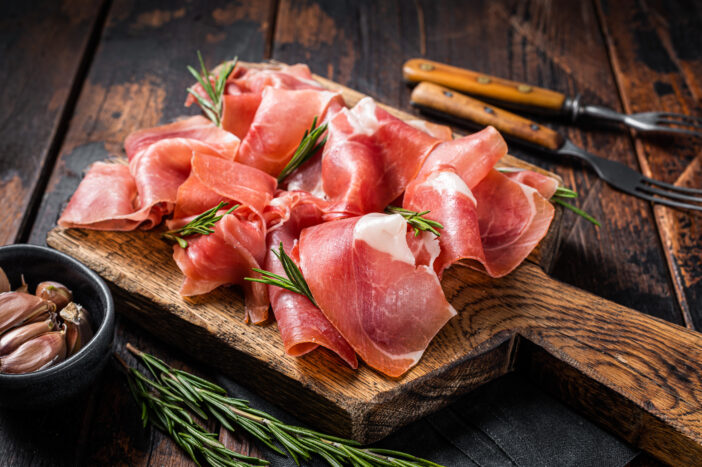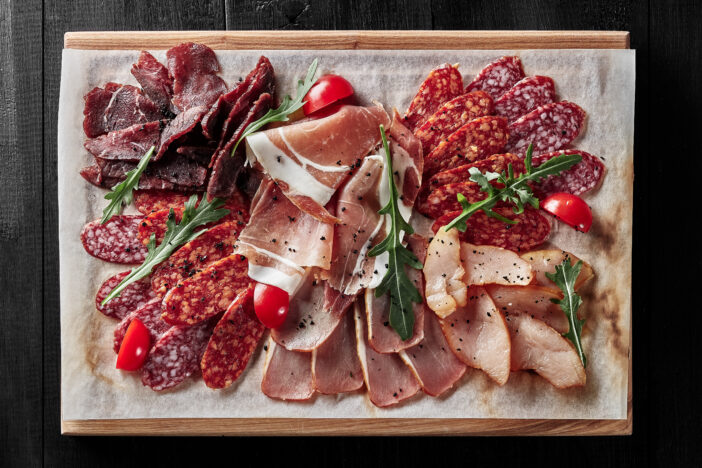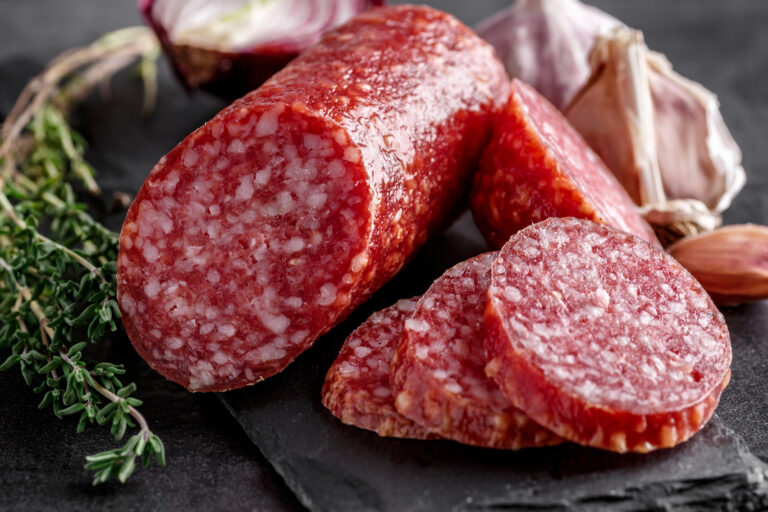6 Capicola Substitutes to Save Money Without Sacrificing Flavor
Exploring capicola substitutes like prosciutto, pancetta, Serrano ham, mortadella, and salami offers flavorful options for your dishes, whether in sandwiches, charcuterie boards, or cooked recipes.

Looking for a budget-friendly alternative to Capicola? Don’t worry, you’re not alone! Whether you’re making a charcuterie board or a sandwich, there are great substitutes to capture its flavor. Try Pancetta for richness or Turkey Ham for a lean option. Your dishes will still be gourmet without breaking the bank!
Disclosure: As an Amazon Associate, this site earns from qualifying purchases. Thank you!
1. Prosciutto: A Close Relative

A versatile substitute for capicola, offering a slightly sweet and savory flavor profile similar to its cured counterpart. Its tender texture melts in the mouth like capicola, making it ideal for various dishes, from salads to pizzas. Prosciutto is readily available and often more budget-friendly than capicola, making it a practical choice for gourmet recipes.
2. Pancetta: The Italian Bacon

Pancetta, often called “Italian bacon,” offers a rich, savory flavor similar to Capicola. Crafted with care, it boasts a delicate texture and subtle taste, perfect for various dishes like carbonara or pizza. Its versatility and easy substitution with Capicola make it a go-to choice for Italian cuisine, allowing you to maintain dish integrity while exploring different flavor profiles.
3. Serrano Ham: A Spanish Alternative

Serrano Ham, a Spanish alternative to Capicola, offers a rich, nutty flavor perfect for various dishes. Enjoyed in thin slices, it maintains its complexity and intense aroma, elevating charcuterie boards, salads, and sandwiches. Aged for months, Serrano Ham boasts savory yet subtly sweet notes, adding an authentic Spanish flair to your culinary creations.
4. Mortadella: The Bologna Option

Mortadella, often dubbed the fancy Italian cousin of American bologna, offers a unique taste and velvety texture compared to Capicola. Lightly spiced with peppercorns and garlic, it brings a mild yet rich flavor to dishes. Use it thinly sliced in sandwiches or diced and fried for added texture in pasta sauces and pizzas.
5. Salami: Versatile and Flavorful

Mortadella, often dubbed the fancy Italian cousin of American bologna, offers a unique taste and velvety texture compared to Capicola. Lightly spiced with peppercorns and garlic, it brings a mild yet rich flavor to dishes. Use it thinly sliced in sandwiches or diced and fried for added texture in pasta sauces and pizzas.
6. Turkey Ham: A Lighter Choice
Mortadella, often dubbed the fancy Italian cousin of bologna, is a unique substitute for Capicola. Originating from Bologna, Italy, it offers a velvety texture with subtle spices and a hint of garlic. While different from Capicola, Mortadella adds complexity to dishes and can be used thinly sliced in sandwiches or diced and fried for added texture in various recipes, from pasta sauces to pizzas.
In the video, Pants Down Aprons On explains –
Pants Down Aprons
- The video demonstrates how to make turkey deli ham at home using easily accessible ingredients.
- It emphasizes the importance of using deboned skinless turkey thigh but mentions chicken as a substitute.
- Curing salt is mentioned as an optional but necessary ingredient for best results.
- Other essential seasonings include salt, garlic powder, smoked paprika, and water, with a mention of vodka for texture.
- The turkey is diced into three specific portions: 350 grams for mincing, 250 grams for creating a paste, and 400 grams to stay whole.
- Each portion is seasoned differently and prepared accordingly, with precise measurements for each seasoning.
- A food processor is used to blend the turkey with egg whites into a smooth paste, which is then mixed with chunks of turkey.
- The mixture is minced using a coarse grinding plate to achieve the desired texture.
- The final mixture is wrapped tightly in plastic wrap, seasoned with smoked paprika, and cooked in a hot water bath or steamer until it reaches the desired internal temperature.
- Once cooked and chilled, the homemade deli ham can be sliced thinly and enjoyed on sandwiches or by itself.
How to Choose the Right Capicola Substitute

When you’re searching for the perfect capicola substitute, it’s crucial to consider a few key aspects to ensure your dishes maintain their intended flavor and texture. Whether you’re making a classic Italian sandwich, a charcuterie board, or a savory recipe, finding the right alternative can keep your meals delicious and your culinary experiments thrilling.
Considering Flavor Profiles
Capicola is known for its distinct spicy and sweet flavor, thanks to the unique combination of spices like black pepper, fennel seeds, and sometimes, red pepper flakes. When looking for a substitute, aim for cured meats that offer a balance between spice and sweetness. Turkey ham, for instance, is a more accessible option that can mimic capicola’s sweetness but may lack the spice level. To adjust, consider adding a dash of the spices used in capicola curing to your recipe. If seeking a closer match in flavor complexity, prosciutto or Pancetta, although differing in fat content, can provide a more authentic taste when seasoned appropriately.
Texture Matters in Substitution
The texture of the capicola is another characteristic that makes it so beloved—tender yet firm. When substituting, note the texture of potential replacements. Turkey ham, while readily available, has a softer texture compared to capicola’s chewy bite. On the other hand, prosciutto shares a closer texture, offering a similarly satisfying chew, especially when sliced thinly. Consider the cooking method and how the meat’s texture will change with heat if your dish requires cooking. For recipes that involve heating, Pancetta could be a more suitable choice due to its fattier content, which can provide a tender texture closer to cooked capicola.
Availability and Accessibility
Let’s face it, part of the challenge is finding a substitute that doesn’t require a scavenger hunt. Depending on where you live, capicola might not be as easily available as other cured meats. Turkey ham stands out for its widespread accessibility and affordability. It’s a versatile option that can be found in most grocery stores. For those leaning towards authenticity but facing availability issues, looking for Italian delicacies shops or specialty stores might be your best bet for finding prosciutto or Pancetta. Remember, online retailers and gourmet food shops are also viable options for sourcing hard-to-find substitutes, expanding your choices beyond local availability.
Choosing the right capicola substitute doesn’t just boil down to flavor and texture—it’s also about what’s accessible to you and fits your culinary needs. Whether you opt for turkey ham for a straightforward swap or venture into using prosciutto or Pancetta for a closer match, each alternative offers a unique way to enjoy your favorite recipes with a twist.
Integrating Capicola Substitutes into Meals

Swapping out capicola doesn’t mean skimping on flavor. With the right substitutes, your meals can still be a hit. Let’s dive into how to seamlessly integrate these alternatives into your favorite dishes.
- Charcuterie Boards: Don’t worry about missing capicola on your charcuterie board. Substitute with prosciutto or salami for a sweet-salty balance or bold flavors. Arrange slices with cheeses, nuts, and fruits for a variety of tastes and textures. Try prosciutto with melon or salami with sharp cheddar for classic pairings.
- Cooking and Baking Uses: Substitutes like pancetta or turkey ham excel in sautéing or baking. Diced pancetta adds richness to pasta sauces, soups, or stews, while chopped turkey ham complements quiches, omelets, or breakfast scrambles without overwhelming other ingredients.
- Creative Recipe Adaptations: Get creative with substitutes like thinly sliced prosciutto or serrano ham in wraps or sandwiches for a unique twist. These alternatives are also great in pizza toppings, adding a subtle, smoky flavor that complements cheeses and vegetables. Try dicing mortadella for savory pastries or adding slices to grilled cheese sandwiches for a decadent lunchtime treat.
Remember, the key to a successful substitution is not just about mimicking the original’s flavor but also about bringing something new and exciting to your meals. Keep experimenting, and you’ll find the perfect fit for your culinary creations.
Making Your Own Capicola at Home
When it comes to finding the perfect substitute for Capicola, nothing beats the satisfaction and flavor of making your own. While the process requires patience, your efforts will be rewarded with a delicious, homemade Capicola that rivals even the finest store-bought versions.
Essential Ingredients and Equipment
To start your Capicola-making journey, you’ll need the right pork cut, such as neck or shoulder (Coppa). Weigh your meat for proper seasoning. For the seasoning blend, gather hot paprika, cayenne pepper, black pepper, red pepper flakes, garlic powder, salt, and a hint of sugar. For equipment, a vacuum sealer or zip-top bag ensures even curing, while a spacious refrigerator is essential for monitoring and maintaining the curing environment.
The Curing Process Explained
For the curing process, mix spices, salt, and sugar thoroughly, then rub into the pork. Seal in a vacuum-sealed or zip-top bag, remove air, and refrigerate for one to three weeks. Massage the meat occasionally. After curing, pat dry, season with white or red wine, and prepare for drying.
Tips for Success
Making Capicola at home is an art and, like all art, requires a bit of finesse to get right. Here are a few tips to help you along the way:
- Patience is key: The curing process can’t be rushed. Give your Capicola the time it needs to fully absorb the flavors and cure properly.
- Keep it even: For an evenly cured Capicola, make sure to rotate and massage the meat periodically during the curing phase.
- Humidity is your friend and foe: While drying, maintaining the right humidity level is crucial to avoid drying out the outer parts too quickly. If necessary, use a curing chamber to control the environment better.
- Safety first: If you’re uncertain about using curing salts, know that they’re optional but can add an extra layer of protection against bacteria, ensuring your homemade Capicola is both delicious and safe to eat.
Armed with the right knowledge, making your own Capicola at home can be an incredibly rewarding experience. Not only do you get to enjoy the fruits of your labor, but you also gain a deeper appreciation for the art of curing meats. So why not give it a try? You might just discover your next favorite hobby.
Frequently Asked Questions
Is hot coppa the same as capicola?
Yes, Coppa and Capicola are the same, both referring to a traditional Italian cured meat prepared from the neck muscle of a pig. It’s seasoned with herbs and spices, then stuffed into a casing to cure, resulting in the renowned delicacy.
Why do people say Gabagool instead of capicola?
The pronunciation “Gabagool” for Capicola comes from dialectical variations, where “c” sounds become “g,” “p” turns into “b,” and the “o” sound is raised to “ooh,” while the final syllable is dropped. This alteration is common in Italian-American slang.
Is prosciutto the same as capicola?
No, prosciutto and capicola are different in both the cut of pork they are made from and their preparation. Capicola comes from the neck and shoulder area, while prosciutto is made from the leg.
What is the best meat for Italian sandwiches?
The best meats for Italian sandwiches are those that suit your taste, traditionally including cured options like capicola, mortadella, salami, pepperoni, and prosciutto. The thickness of slicing these meats can significantly impact the sandwich’s texture.
What do Italians call capicola?
In Italy, capicola is a traditional cured meat known for its historical origins with Italian farmers, who cured it using salt and pepper. The term “capicola” translates to “top of the neck,” referring to where the meat is sourced from on the pig.






